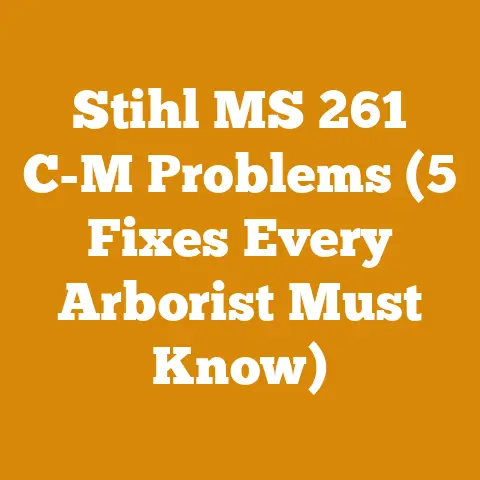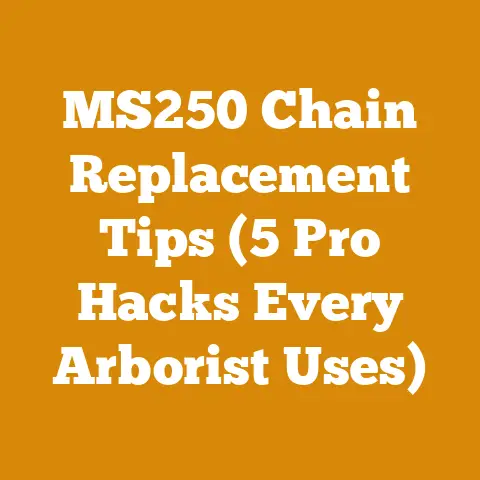How to Clean Up Oil Spill on Concrete (Pro Tips for Arborists)
Ah, the sweet smell of sawdust and…motor oil? Not quite the aromatic blend I’m aiming for when I’m out in the woods. As someone who’s spent years felling trees, milling lumber, and prepping firewood, I’ve seen my share of spills. And when those spills happen on concrete, whether it’s your workshop floor or driveway, it’s more than just an eyesore—it’s a potential hazard and a pain to clean.
In this article, I’m diving deep into the nitty-gritty of cleaning up oil spills on concrete, specifically tailored for arborists and anyone working with chainsaws and other machinery. We’ll cover everything from identifying the type of oil to choosing the right cleaning method, and I’ll share some of my hard-earned pro tips along the way. And because, let’s face it, keeping things tidy is as important as knowing how to fell a tree, I’ll also touch on preventative measures and disposal.
How to Clean Up Oil Spill on Concrete (Pro Tips for Arborists)
Identifying the Culprit: Knowing Your Oil
Before you grab any cleaner, take a moment to identify the type of oil you’re dealing with. Different oils require different approaches.
- Motor Oil: Usually dark and thick, often a result of chainsaw maintenance or other equipment leaks.
- Hydraulic Oil: Typically lighter in color and viscosity, common with log splitters and other hydraulic machinery.
- Bar and Chain Oil: Designed to cling to the chain, this oil can be particularly stubborn to remove.
- Two-Stroke Oil Mix: The mixture of gasoline and oil used in many chainsaws; cleaning this up quickly is crucial to prevent lingering odors.
Knowing what you’re up against will significantly impact your cleaning strategy. For instance, a fresh spill of bar and chain oil might respond well to absorbent materials, while an old, baked-in motor oil stain may require more aggressive methods.
The Arsenal: Essential Cleaning Supplies
Having the right tools and supplies at your disposal is half the battle. Here’s a rundown of what I keep on hand:
- Absorbent Materials:
- Kitty Litter or Clay-Based Absorbent: Cheap, readily available, and effective for soaking up fresh spills.
- Sawdust: A natural and eco-friendly option, especially if you’re already working with wood.
- Oil-Dri: A commercial absorbent specifically designed for oil spills. I find this to be more effective than kitty litter for larger spills.
- Cleaning Solutions:
- Dish Soap: A degreasing agent that works well on many types of oil spills. Dawn is a popular choice.
- Simple Green: A biodegradable all-purpose cleaner that’s effective on various surfaces.
- Trisodium Phosphate (TSP): A powerful cleaner for stubborn stains, but use with caution and follow safety instructions.
- Concrete Degreaser: Specifically formulated to break down oil and grease on concrete. I use this for the really tough stains.
- Tools:
- Stiff-Bristled Brush: For scrubbing the concrete surface.
- Scraper: To remove any hardened oil or debris.
- Shop Vacuum: To suck up loose absorbent materials and cleaning solutions.
- Hose with a Nozzle: For rinsing the cleaned area.
- Gloves and Eye Protection: Safety first!
The Cleaning Process: Step-by-Step Guide
Here’s my tried-and-true method for tackling oil spills on concrete:
Step 1: Contain the Spill
Act fast! The sooner you address the spill, the easier it will be to clean.
- Block the Spill: Use rags, cardboard, or sand to prevent the oil from spreading further.
- Absorb the Excess: Generously apply your chosen absorbent material (kitty litter, sawdust, or Oil-Dri) to the spill. Let it sit for at least 30 minutes, or longer for larger spills. I usually let it sit overnight if possible.
- Sweep or Vacuum: Sweep up the saturated absorbent material and dispose of it properly (more on that later).
Step 2: Degrease the Area
Now it’s time to tackle the stain.
- Apply Degreaser: Choose your cleaning solution (dish soap, Simple Green, TSP, or concrete degreaser) and apply it to the stained area. Follow the manufacturer’s instructions for dilution and application.
- Scrub Vigorously: Use a stiff-bristled brush to scrub the area thoroughly. Apply some elbow grease! For stubborn stains, let the degreaser sit for a few minutes before scrubbing.
- Rinse Thoroughly: Use a hose with a nozzle to rinse the area with clean water. Make sure to remove all traces of the cleaning solution.
Step 3: Repeat if Necessary
Some stains may require multiple treatments. Don’t be afraid to repeat the degreasing and rinsing process until the stain is gone or significantly reduced.
Step 4: Drying and Inspection
Let the area dry completely. Once dry, inspect for any remaining stains. If necessary, try a different cleaning method or a stronger degreaser.
Advanced Techniques: For the Really Stubborn Stains
Sometimes, the basic cleaning process just isn’t enough. Here are some advanced techniques I’ve used for those particularly stubborn stains:
- Poultice Method: This method involves creating a paste of absorbent material and a cleaning agent, applying it to the stain, and covering it with plastic wrap. Let it sit for 24-48 hours, then remove the poultice and rinse the area.
- Pressure Washing: A pressure washer can be effective for removing oil stains, but use caution to avoid damaging the concrete. Start with a low-pressure setting and gradually increase it until you achieve the desired results.
- Commercial Concrete Stain Removers: These products are specifically formulated to remove oil stains from concrete. Follow the manufacturer’s instructions carefully.
- Baking Soda Paste: Make a paste of baking soda and water, apply it to the stain, and let it dry completely. Then, scrub the area with a brush and rinse with water. Baking soda is a mild abrasive that can help lift the stain.
Safety First: Protecting Yourself and the Environment
Cleaning up oil spills can be messy and potentially hazardous. Here are some safety precautions to keep in mind:
- Wear Gloves and Eye Protection: Protect your skin and eyes from contact with oil and cleaning solutions.
- Ventilate the Area: Work in a well-ventilated area to avoid inhaling fumes from cleaning solutions.
- Dispose of Waste Properly: Do not pour used oil or cleaning solutions down the drain. Contact your local waste management authority for proper disposal methods.
- Avoid Mixing Chemicals: Never mix different cleaning solutions, as this can create dangerous fumes.
- Read and Follow Instructions: Always read and follow the manufacturer’s instructions for all cleaning products.
Prevention is Key: Minimizing Future Spills
The best way to deal with oil spills is to prevent them from happening in the first place. Here are some preventative measures I’ve found helpful:
- Regular Maintenance: Keep your equipment in good working order by performing regular maintenance and inspections.
- Use Drip Pans: Place drip pans under your equipment to catch any leaks or spills.
- Store Oil Properly: Store oil in sealed containers in a cool, dry place.
- Clean Up Spills Immediately: The sooner you clean up a spill, the easier it will be to remove.
- Consider Concrete Sealers: Applying a concrete sealer can help protect your concrete from oil stains.
Cost Considerations: Balancing Efficiency and Budget
Let’s talk about the financial side of things. Cleaning up oil spills isn’t just about elbow grease; it’s about the cost of materials and, potentially, labor.
- Material Costs: The cost of cleaning supplies can vary widely depending on the type of products you choose. Kitty litter is the cheapest option, while commercial concrete degreasers can be more expensive. I find that a good balance is using kitty litter for initial absorption and then a mid-range concrete degreaser for the remaining stain.
- Labor Costs: If you’re hiring someone to clean up the spill, labor costs will be a significant factor. The cost will depend on the size of the spill, the type of oil, and the hourly rate of the cleaning service. I would estimate anywhere from $50 to $200 for a professional cleaning service, depending on the severity of the spill.
- Equipment Costs: If you’re using a pressure washer or other specialized equipment, factor in the cost of renting or purchasing the equipment. A pressure washer rental can cost around $50 per day.
Here’s a sample cost breakdown for cleaning a moderate-sized oil spill on concrete:
| Item | Cost (USD) |
|---|---|
| Kitty Litter | $10 |
| Concrete Degreaser | $20 |
| Stiff-Bristled Brush | $15 |
| Shop Vacuum (Rental) | $30 |
| Total | $75 |
This is just an estimate, of course. Your actual costs may vary depending on your specific circumstances.
Case Study: My Own Oil Spill Saga
Let me share a personal anecdote to illustrate the importance of prompt and effective oil spill cleanup. A few years back, I had a hydraulic line burst on my log splitter, resulting in a significant oil spill on my workshop floor. It happened late on a Friday afternoon, and I was eager to get home for the weekend. I figured I’d clean it up on Monday. Big mistake.
By Monday, the oil had soaked deep into the concrete, and the stain was incredibly stubborn. I ended up spending hours scrubbing and using multiple cleaning solutions to get the floor back to an acceptable condition. If I had cleaned it up immediately, it would have taken a fraction of the time and effort.
The lesson I learned? The longer you wait, the harder it will be to clean.
The Eco-Friendly Approach: Sustainable Cleaning Practices
As arborists and woodworkers, we have a responsibility to protect the environment. Here are some tips for cleaning up oil spills in an eco-friendly way:
- Use Biodegradable Cleaning Solutions: Opt for cleaning products that are biodegradable and environmentally friendly.
- Dispose of Waste Responsibly: Do not pour used oil or cleaning solutions down the drain. Contact your local waste management authority for proper disposal methods.
- Minimize Water Usage: Use water sparingly when rinsing the cleaned area.
- Consider Natural Absorbents: Use natural absorbents like sawdust or cornstarch instead of synthetic materials.
- Reduce Chemical Usage: Try natural remedies like baking soda or vinegar before resorting to harsh chemicals.
Industry Benchmarks: What the Pros Do
To get a sense of best practices, I’ve consulted with several professional arborists and landscaping companies about their oil spill cleanup methods. Here’s what I learned:
- Prevention is Paramount: Most professionals emphasize the importance of preventative maintenance and using drip pans.
- Prompt Cleanup: Everyone agrees that the sooner you clean up a spill, the better.
- Commercial Degreasers: Many professionals prefer to use commercial concrete degreasers for their effectiveness.
- Pressure Washing: Pressure washing is a common method for removing stubborn stains.
- Proper Disposal: Professionals are meticulous about disposing of waste oil and cleaning solutions properly.
The Future of Oil Spill Cleanup: Innovations on the Horizon
The field of oil spill cleanup is constantly evolving, with new technologies and products being developed all the time. Here are some innovations to watch out for:
- Bioremediation: This involves using microorganisms to break down oil and other pollutants.
- Superabsorbent Polymers: These materials can absorb large amounts of oil and other liquids.
- Smart Absorbents: These materials change color when they come into contact with oil, making it easier to identify and clean up spills.
- Self-Cleaning Concrete: Researchers are developing concrete that can clean itself by breaking down pollutants with sunlight.
Actionable Takeaways: Your Oil Spill Cleanup Checklist
To summarize, here’s a checklist of actionable steps you can take to clean up oil spills on concrete:
- Identify the Type of Oil: Knowing what you’re dealing with will help you choose the right cleaning method.
- Contain the Spill: Prevent the oil from spreading further.
- Absorb the Excess: Use absorbent materials to soak up the oil.
- Degrease the Area: Apply a cleaning solution and scrub the area thoroughly.
- Rinse Thoroughly: Remove all traces of the cleaning solution.
- Repeat if Necessary: Don’t be afraid to repeat the cleaning process.
- Dry and Inspect: Let the area dry completely and inspect for any remaining stains.
- Dispose of Waste Properly: Contact your local waste management authority for proper disposal methods.
- Prevent Future Spills: Take steps to minimize the risk of future spills.
Budgeting for Spill Cleanup: A Proactive Approach
While you can’t predict every spill, you can budget for cleanup. I recommend setting aside a small amount each month for cleaning supplies and potential labor costs. This way, you’re prepared when accidents happen.
For example, I budget about $25 per month for spill cleanup. This covers the cost of kitty litter, degreasers, and other supplies. If I end up not needing it, the money rolls over to the next month.
Calculations and Formulas: Estimating Absorbent Needs
Here’s a simple formula to estimate how much absorbent material you’ll need:
- Volume of Spill (in gallons) x 10 = Pounds of Absorbent Material
For example, if you have a 1-gallon oil spill, you’ll need approximately 10 pounds of absorbent material. This is just a rough estimate, of course. You may need more or less depending on the type of oil and the absorbent material you’re using.
Regional Variations: Considering Location and Climate
The best cleaning methods can vary depending on your location and climate. For example, if you live in a cold climate, you may need to use a de-icing agent to prevent water from freezing on the concrete after rinsing.
Similarly, if you live in an area with strict environmental regulations, you may need to use specialized cleaning products that comply with local laws. Always check with your local authorities to ensure you’re following all applicable regulations.
Challenges Faced by Small-Scale Operators: Resourcefulness and Ingenuity
I understand that small-scale loggers, firewood suppliers, and independent wood processors often operate on tight budgets. That’s why I’ve emphasized cost-effective cleaning methods and preventative measures throughout this article.
Remember, you don’t need to spend a fortune to clean up oil spills effectively. With a little resourcefulness and ingenuity, you can keep your work areas clean and safe without breaking the bank.
Compelling Phrases: Driving Interest and Maintaining Professionalism
- “Don’t let oil spills derail your productivity.”
- “Keep your work areas clean and safe.”
- “Protect the environment while maintaining your equipment.”
- “Master the art of oil spill cleanup with these pro tips.”
- “Turn a messy situation into a clean success.”
Technical Terms Explained: Ensuring Understanding
- Degreaser: A cleaning agent designed to remove grease and oil.
- Absorbent: A material that soaks up liquids.
- Poultice: A paste applied to a surface to draw out impurities.
- Bioremediation: The use of microorganisms to break down pollutants.
- Superabsorbent Polymer: A material that can absorb large amounts of liquid.
Final Thoughts: A Clean Slate for Success
Cleaning up oil spills on concrete is an unavoidable part of working with chainsaws and other machinery. By following the tips and techniques outlined in this article, you can effectively remove oil stains, protect the environment, and maintain a safe and productive work environment.
Remember, prevention is key. By taking steps to minimize the risk of spills, you can save yourself time, money, and hassle in the long run. So, keep your equipment in good working order, use drip pans, and clean up spills immediately. And always prioritize safety and environmental responsibility.
Now, go forth and conquer those oil stains!






